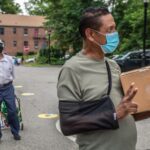Increasing globalization calls for undergraduate nursing programs to develop opportunities for students to participate in study-abroad activities. For some students, the cost of such activities can prohibit participation. The influx of refugees to the United States provides an alternative opportunity for students to think and act globally without the cost of travel. This article discusses how a community health assessment, completed through a partnership with a public health department, addressed barriers to emergency preparedness for Somali refugees. Students collected data using a focus group of 10 female Somali refugees. The focus group participants had limited understanding of English and fewer than half could read written Somali. Students gained insight into the language barriers among the refugees and the need for cultural sensitivity. They provided outreach, met Somali community leaders, and started the process of communication on emergency preparedness.
The management of volunteers – What can human resources do? A review and research agenda
There is an increasing interest from scholars and practitioners in understanding how non-profit organizations can design and implement human resources (HR) practices to enhance desirable volunteer attitudes and behaviors. This paper presents a comprehensive overview of existing studies on the relationship between HR practices and volunteering outcomes. We use the ability-motivation-opportunity model as a guiding…

